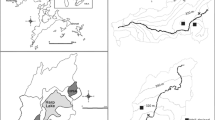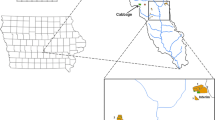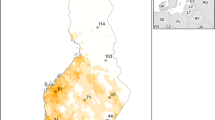Abstract
Yields and retention of dissolved inorganic nitrogen (DIN: NO3 − + NH4 +) and nitrate concentrations in surface runoff are summarized for 28 high elevation watersheds in the Sierra Nevada of California and Rocky Mountains of Wyoming and Colorado. Catchments ranged in elevation from 2475 to 3603 m and from 15 to 1908 ha in area. Soil cover varied from 5% to nearly 97% of total catchment area. Runoff from these snow-dominated catchments ranged from 315 to 1265 mm per year. In the Sierra Nevada, annual volume-weighted mean (AVWM) nitrate concentrations ranged from 0.5 to 13 μM (overall average 5.4 μM), and peak concentrations measured during snowmelt ranged from 1.0 to 38 μM. Nitrate levels in the Rocky Mountain watersheds were about twice those in the Sierra Nevada; average AVWM NO3 − was 9.4 μM and snowmelt peaks ranged from 15 to 50 μM. Mean DIN loading to Rocky Mountain watersheds, 3.6 kg ha−1 yr−1, was double the average measured for Sierra Nevada watersheds, 1.8 kg ha−1 yr−1. DIN yield in the Sierra Nevada, 0.69 kg ha−1 yr−1, was about 60% that measured in the Rocky Mountains, 1.1 kg ha−1 yr−1. Net inorganic N retention in Sierra Nevada catchments was 1.2 kg ha−1 yr−1 and represented about 55% of annual DIN loading. DIN retention in the Rocky Mountain catchments was greater in absolute terms, 2.5 kg ha−1 yr−1, and as a percentage of DIN loading, 72%.
A correlation analysis using DIN yield, DIN retention and surface water nitrate concentrations as dependent variables and eight environmental features (catchment elevation, slope, aspect, roughness, area, runoff, soil cover and DIN loading) as independent variables was conducted. For the Sierra Nevada, elevation and soil cover had significant (p > 0.1) Pearson product moment correlations with catchment DIN yield, AVWM and peak snowmelt nitrate concentrations and DIN retention rates. Log-linear regression models using soil cover as the independent variable explained 82% of the variation in catchment DIN retention, 92% of the variability in AVWM nitrate and 85% of snowmelt peak NO3 −. In the Rocky Mountains, soil cover was significantly (p < 0.05) correlated with DIN yield, AVWM NO3 − and DIN retention expressed as a percentage of DIN loading (%DIN retention). Catchment mean slope and terrain roughness were positively correlated with steam nitrate concentrations and negatively related to %DIN retention. About 91% of the variation in DIN yield and 79% of the variability in AVWM NO3 − were explained by log-linear models based on soil cover. A log-linear regression based on soil cover explained 90% of the variation of %DIN retention in the Rocky Mountains.
Similar content being viewed by others
References
Andrew N, Bleich V & August P (1999) Habitat selection by mountain sheep in the Sonoran desert: Implications for conservation in the United States and Mexico. CaliforniaWildland Conservation Bull. 12: 1–33
Baron JS (Ed) (1992) Biogeochemistry of Subalpine Ecosystem: Loch Vale Watershed. Springer-Verlag, New York
Baron JS & Campbell DH (1997) Nitrogen fluxes in a high elevation Colorado Rocky Mountain Basin. Hydrological Processes 11: 783–799
Baron JS, Ojima DS, Holland EA & Parton WJ (1994) Analysis of nitrogen saturation potential in Rocky Mountain tundra and forest: Implications for aquatic systems. Biog. 27: 61–82
Bieber AJ, Williams MW, Johnson MJ & Davinroy TC (1998) Nitrogen transformations in alpine talus fields, Green Lakes Valley, Front Range, Colorado, USA. Arctic and Alpine Research 30: 266–271
Brooks PD, Williams MW & Schmidt SK (1996) Microbial activity under alpine snowpacks, Niwot Ridge, Colorado. Biogeochemistry 32: 93–113
Brooks PD, Williams MW & Schmidt SK (1998) Soil inorganic nitrogen and microbial biomass dynamics before and during spring snowmelt. Biog. 43: 1–15
Brooks PD, Campbell DH, Tonnessen KA & Heuer K (1999) Natural variability in N export from headwater catchments: snow cover controls on ecosystem N retention. Hydrological Processes 13: 2191–2201
Brooks PD & Williams MW (1999) Snowpack controls on nitrogen cycling and export in seasonally snow-covered catchments. Hydrological Processes 13: 2177–2190
Campbell DH, Clow DW, Ingersoll GP, Mast MA, Spahr NE & Turk JT (1995) Processes controlling the chemistry of two snowmelt-dominated streams in the Rocky Mountains. Water Resources Research 31: 2811–2821
Church TM (1999) Atmospheric organic nitrogen deposition explored at workshop. Eos, Transactions of the American Geophysical Union 80: 355
Cline DW, Bales RC & Dozier J (1998) Estimating the spatial distribution of snow in mountain basins using remote sensing and energy balance modeling. Water Resources Research 34: 1275–1285.
Clow DW & Sueker JK (2000) Relations between basin characteristics and stream water chemistry in alpine/subalpine basins in Rocky Mountain National Park, Colorado. Water Resources Research 36: 49–61
Cooper DM, Jenkins A, Skeffington R & Gannon B (2000) Catchment-scale simulation of stream water chemistry by spatial mixing: Theory and application. J. of Hydrology 233: 121–137
Creed IF & Band LE (1998) Export of nitrogen from catchments within a temperate forest: Evidence for a unifying mechanism regulated by variable source area dynamics. Water Resources Research 34: 3105–3120
Dozier J & Frew J (1990) Rapid calculation of terrain parameters for radiation modeling from digital elevation data. IEEE Transactions on Geoscience and Remote Sensing 28: 963–969
Fenn ME, Poth MA, Aber JD, Baron JS, Bormann BT, Johnson DW, Lemly AD, McNulty G, Ryan DF & Stottlemyer R (1998) Nitrogen excess in North American Ecosystems: predisposing factors, ecosystem responses, and management strategies. Ecological Applications 8: 706–733
Fisk MC, Schmidt SK & Seastedt TR (1998) Topographic patterns of above - and belowground production and nitrogen cycling in alpine tundra. Ecology 79: 2253–2266
Galloway JN, Levy H III & Kasibhatla PS (1994) Year 2020: consequences of population growth and development on deposition of oxidized nitrogen. Ambio 23: 12–123
Gundersen P, Emmett BA, Kjonaas OJ, Koopmans CJ & Tietema A (1998) Impact of nitrogen deposition on nitrogen cycling in forests: A synthesis of NITREX data. Forest Ecology and Management 101: 37–55
Hedin LO, Armesto JJ & Johnson AH (1995) Patterns of nutrient loss from unpolluted, oldgrowth temperate forests: Evaluation of biogeochemical theory. Ecology 76: 493–509
Heuer K, Brooks PD & Tonnessen KA (1999) Nitrogen dynamics in two high elevation catchments during spring snowmelt 1996, Rocky Mountains, Colorado. Hydrological Processes 13: 2203–2214
Howarth RW, Billen G, Swaney D, Townsend A, Jaworski N, Lajtha K, Downing JA, Elmgren R, Caraco N, Jordan T, Berendse F, Freney J, Kudeyarov V, Murdoch P & Ahao-Liang S (1996) Regional nitrogen budgets and riverine N and P fluxes for the drainages to the North Atlantic Ocean: Natural and human influences. Biog. 38: 1–96
Jassby AD, Reuter JE Axler RP Goldman CR & Hackley SH (1994) Atmospheric deposition of nitrogen and phosphorus in the annual nutrient load of Lake Tahoe (California, Nevada). Water Resources Research 30: 2207–2216
Kendall C, Campbell DH, Burns DA, Shanely JB, Silva SR & Chang CCY (1995) Tracing sources of nitrate in snowmelt runoff using the oxygen and nitrogen isotopic compositions of nitrate. In: Tonnessen KA, Williams MW & Tranter M (Eds) Biogeochemistry of Seasonally Snow-Covered Catchments (pp 339–347). IAHS Publication no. 228
Kiefer JW & ME Fenn (1997) Using vector analysis to assess nitrogen status of Ponderosa and Jeffrey pine along deposition gradients in forests of southern California. Forest Ecology and Management 94: 47–59
Landers DH, Eilers J, Brakke W, Overton W, Kellar M, Silverstein R, Schonbrod R, Crowe R, Linthurst J, Omernik S, Teague S & Meier E (1987) Western Lake Survey, Phase I: Characteristics of Lakes in the Western United States. Volume I. Population Descriptions and Physico-chemical Relationships. U.S. Environmental Protection Agency. Washington, DC
Lek S, Guiresse M & Giraudel JL (1999) Predicting stream nitrogen concentration from watershed features using neural networks. Water Research 33: 3469–3478
Lewis WM Jr, Melack JM, McDowell WH, McClain M & Richey JE (1999) Nitrogen yields from undisturbed watersheds in the Americas. Biog. 46: 149–162
Lewis WM Jr (in press) Yield of nitrogen from undisturbed watersheds of the United States and its relationship to nitrogen deposition. Biog.
Leydecker A, Sickman JO & Melack JM (1999) Episodic lake acidification in the Sierra Nevada, California. Water Resources Research 35: 2793–2804
Lovett GM, Weathers KC & Sobczak WV (2000) Nitrogen saturation and retention in forested watersheds of the Catskill Mountains, New York. Ecological Applications 10: 73–84
Magill AH, Downs MR, Nadelhoffer KJ, Hallet RA & Aber JD (1997) Biogeochemical response of forest ecosystem to simulated chronic nitrogen deposition. Ecological Applications 7: 402–415
Meixner T, Brown A & Bales RC (1998) Importance of biogeochemical processes in modeling stream chemistry in two watersheds in the Sierra Nevada, California. Water Resources Research 34: 3121–3133
Meixner T, Gupta HV, Bastidas LA & Bales RC (1999) Sensitivity analysis using mass flux and concentration. Hydrological Processes 13: 2233–2244
Melack JM & Stoddard JL (1991) Sierra Nevada, California. In: Charles DF (Ed) Acidic Deposition and Aquatic Ecosystems (pp 503–530). Springer-Verlag, New York, NY
Melack JM, Sickman JO, Leydecker A & Marrett D (1998) Comparative analysis of highaltitude lakes and catchments in the Sierra Nevada: Susceptibility to acidification. Final report, contract A032-188, California Air Resources. Board, Sacramento, California
Meybeck M (1982) Carbon, nitrogen, and phosphorus transport by world rivers. American J of Sci. 282: 401–450
Nadelhoffer KJ, Downs MR, Fry B, Aber JD, Magill AH & Melillo JM (1995) The fate of 15N-labelled nitrate additions to a northern hardwood forest in eastern Maine, USA. Oecologia 103: 292–301
Neff JC, Holland EA, Dentener FJ, McDowell WH & Russel KM (in press) Atmospheric organic nitrogen: Implications for the Global N cycle. Biog.
Peters NE & Leavesley GH (1995) Biotic and abiotic processes controlling water chemistry during snowmelt at Rabbit Ears Pass, Rocky Mountains, Colorado, USA. Water, Air and Soil Poll. 79: 171–190
Reuss JO, Vertucci FA, Musselman & Sommerfeld (1995) Chemical fluxes and sensitivity to acidification of two high-elevation catchments in southernWyoming. J. of Hydrology 173: 165–189
Schimel JP, Kielland K & Chapin FS (1996) Nutrient availability and uptake by tundra plants. In: Reynolds JF & Tenhunen JD (Eds) Landscape function: Implications for Ecosystem Response to Disturbance: A Case Study in Arctic Tundra (pp 201–221). Springer-Verlag New York, NY
Sickman JO & Melack JM (1998) Nitrogen and sulfate export from high elevation catchments of the Sierra Nevada, California. Water, Air and Soil Poll. 105: 217–226
Sickman JO, Leydecker A & Melack JM (in press) Nitrogen mass balances and abiotic controls on N retention and yield in high-elevation catchments of the Sierra Nevada, California, U.S.A.Water Resources Research
Sievering H, Rusch D & Caine N (1996) Nitric acid, particulate nitrogen and ammonium in the continental free troposphere: nitrogen deposition to an alpine tundra ecosystem. Atmospheric Environ. 30: 2527–2537
Stanton ML, Rejmanek M & Galen C (1994) Changes in vegetation and soil fertility along a predictable snowmelt gradient in the Mosquito Range, Colorado, U.S.A. Arctic and Alpine Research 26: 364–374
Stednick JD (1989) Hydrochemical characterization of alpine and alpine-subalpine stream waters, Colorado Rocky Mountains, U.S.A. Arctic and Alpine Research 21: 276–282
Stoddard JL (1994) Long-term changes in watershed retention of nitrogen. In: Baker LA (Ed) Environmental Chemistry of Lake and Reservoirs (pp 223–284). Adv. Chem. Ser. No. 237. American Chemical Society, Washington, DC
Stoddard JL (1995) Episodic acidification during snowmelt of high elevation lakes in the Sierra Nevada Mountains of California. Water, Air and Soil Poll. 85: 353–358
Stoddard JL, Driscoll CT, Kahl JS & Kellogg JP (1998) Can site-specific trends be extrapolated to a region? An acidification example for the northeast. Ecological Applications 8: 288–299
Stoddard JL, Jeffries DS, Lukewille A, Clair TA, Dillon PJ, Driscoll CT, Forsius M, Johannessen M, Kahl JS, Kellogg JH, Kemp A, Mannio J, Monteith DT, Murdoch PS, Patrick S, Rebsdorf A, Skjelkvale BL, Stainton MP, Traaen T, van Dam H, Webster KE, Wieting J & Wilander A (1999) Regional trends in aquatic recovery from acidification in North America and Europe. Nature 401 575–578
Stottlemyer R & Troendle CA (1992) Nutrient concentration patterns in streams draining alpine and subalpine catchments, Fraser Experimental Forest, Colorado. J. of Hydrology 140: 179–208
Tietema A, Emmet BA, Gunderen P, Kjonaas OJ & Koopmans C (1998) The fate of 15N-labelled nitrogen deposition in coniferous forest ecosystems. Forest Ecology and Management 101: 19–27
Williams MW, Bales RC, Brown AD & Melack JM (1995) Fluxes and transformations of nitrogen in a high-elevation catchment, Sierra Nevada. Biog. 28: 1–31
Williams MW, Baron JS, Caine N, Sommerfeld R & and Sanford R Jr. (1996a) Nitrogen saturation in the Rocky Mountains. Environ. Science and Technol. 30: 640–646
Williams MW, Brooks PD, Mosier A & Tonnessen KA (1996b) Mineral nitrogen transformations in and under seasonal snow in a high-elevation catchment in the Rocky Mountains, United States. Water Resources Research V32: 3161–3171
Williams MW (1997) Nitrogen cycling and critical loads in high-elevation catchments of the Colorado Front Range. Eos, Transactions of the American Geophysical Union, S168.
Williams MW, Davinroy T & Brooks PD (1997) Organic and inorganic nitrogen pools in talus fields and sub-talus water, Green Lakes Valley, Colorado Front Range Hydrological Processes 11: 1747–1760
Williams MW & Melack JM (1991) Precipitation chemistry in and ionic loading to an alpine basin, Sierra Nevada. Water Resources Research 27: 1563–1574
Williams MW & Tonnessen KA (2000) Critical loads for inorganic nitrogen deposition in the Colorado Front Range, USA. Ecological Applications 10(6): 1648–1665
Wood EF, Sivapalan M, Beven K & Band L (1988) Effects of spatial variability and scale with implications to hydrological modeling. J. of Hydrology 102: 29–47
Vitousek PM, Hedin LO, Matson PA, Fownes JH & Neff JC (1998) Within-system element cycles, input-output budgets and nutrient limitation. In: Groffman PM & Pace ML (Eds) Successes, Limitation and Frontiers in Ecosystem Science (pp 432–451). Springer, New York, NY
Vitousek PM & Field CB (1999) Ecosystem constraints to symbiotic nitrogen fixers: a simple model and its implications. Biogeochemistry 46: 179–202
Author information
Authors and Affiliations
Corresponding author
Rights and permissions
About this article
Cite this article
Sickman, J.O., Melack, J.M. & Stoddard, J.L. Regional analysis of inorganic nitrogen yield and retention in high-elevation ecosystems of the Sierra Nevada and Rocky Mountains. Biogeochemistry 57, 341–374 (2002). https://doi.org/10.1023/A:1016564816701
Issue Date:
DOI: https://doi.org/10.1023/A:1016564816701




